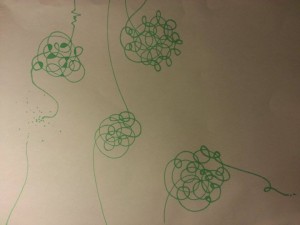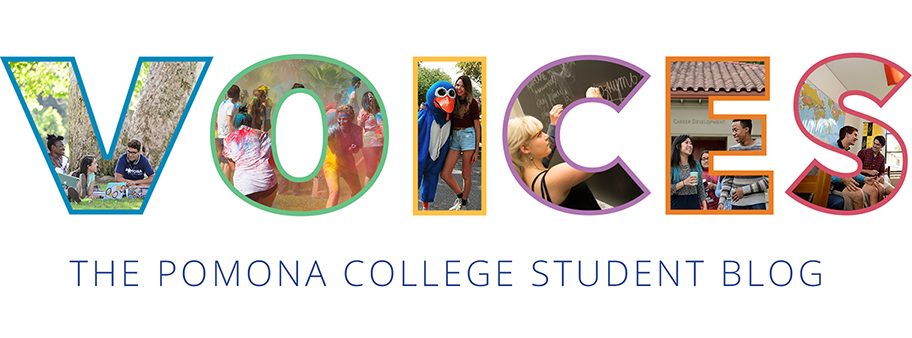
I sighed, pushed my chair back with the back of my knees, and stood up. I placed one hand behind my back, looking down at my sketch one last time before diving into my 15-second interpretative dance. Fifteen quizzical faces – expressing a combination of confusion, interest, and delight – looked back at me as I used one finger to draw swirls in the air.
No, this was not for some acting class, nor for a modern choreography class. This was an activity for my ID1 for a discussion led by one of my peers regarding the purposes and merits of arts education.
Every first-year partakes in the ID1 program (first-year seminar), and each Tuesday and Thursday session has been filled with inspiration and enlightenment.
As I began college at Pomona, I still had many doubts about attending a private university, namely: “Will I be gaining experiences that I could not gain elsewhere?” As I calculated the relatively few number of hours I spent in class and realized that much of my tuition was going towards these limited hours, I wondered if the education I was gaining at Pomona – which comes in many forms – was what I could be only getting here, and not through some educational alternative. With the quantity and quality of rising alternative educational options – community college and MOOCs (massive online open courses for a degree) – and the tuition my peers and I face, this was an issue I have voiced with many alumni, faculty, and students, both at formal events such as the Annual Trustee/Student Retreat and through casual conversation. Each time, others responded to my question with a loose wording of “learning isn’t just about academics and studying,” but no answer personally convinced me about just exactly what I was doing here at Pomona.

However, it was through my ID1 course that I found my own answer to this question. Although I love my other classes as well, it is 1) the people who share a common interest in education but differ in drastically diverse backgrounds, and 2) the ideas that fuse from the intersection of these different perspectives, that have invaluably informed my understanding of education in a way deeper than any lecture, online video, or book could have. It is this experience – of watching readings come alive through poignant questions and conversations that diverge in unimaginable ways – that makes every hour spent on this class so worth it. The ideas I’ve been collecting have undoubtedly informed my understanding of different educational philosophies, challenged me to articulate my own thoughts, and pushed me to think about my personal educational philosophy and how that will impact the decisions I make here for the next four years.

Each line starts from a different part of the page, indicating that each person’s educational experience has a different starting point. Each one of the doodles is one line, indicating that every new idea one gains simply adds to what he or she already knows. The lines overlap and intersect in many points, symbolizing the beauty of not only venturing out and exploring new ideas, but the interaction of new ideas with old ideas.
Although each “doodle” may appear messy, I intended that to illustrate how each doodle was actually made up of one line – and how education can help us find order in chaos by illuminating relationships between different ideas. The lines often take unexpected turns, loop in one direction then the next, and the filled in spaces represent innovation that occurs at the intersection of ideas.
The EKG-esque pattern in the line symbolizes the power of education to bring ideas to life, and what I intended to look like “sparks” or “fireworks” symbolizes the joy of a breakthrough in ideas, and how even when one’s education culminates in a significant accomplishment, education (the line in the doodle) still continues and it trails off the page where it reincarnates as another line that enters the page and forms yet another doodle.
What dictates the hierarchy of art forms we value?
How can the principles of our activity be applied to using art to advocate for social justice?
How does the interaction between the presenter/audience illuminate how art can effectively help open our minds to new perspectives? What aspects of this activity show us how abstract demonstrations actually hinder art from being an effective mode of expression? Since the presenter does not have an opportunity to verbally explain his or her drawing and dance, are audience members really gaining an understanding of the presenter’s perspective? If the ideas presented are intended to be abstract, aren’t audience members forced to impose their own understanding of education on the presenter’s dance interpretation simply to make sense of the movements that audience members perceive? And doesn’t that, in turn, reinforce each audience member’s perspective on education?
These are all typical questions an hour-long class attempts to address.
It was interesting to note that in this exercise, no one called on “monetary gain” or “practicality in future job searches” as purposes of education, but each person presented higher ideals of creativity, education as a form of rebirth, etc.
As conversations meandered out of the classroom, these thoughts marinated in our minds long after we gathered for another spontaneous ID1 lunch to continue these discussions.
Although initially hesitant and slightly embarrassed by the prospect of dancing in front of my peers, by the end of the activity, I was deeply grateful for what
1) thinking through my thoughts on the purpose of education,
2) attempting to convey them on one sheet of paper, and
3) using dance to convey that interpretation
illuminated about our collective perspectives on education.
After all, isn’t that what education is about? Realizing the fault in your initial intuitions about a situation, bonding through risk, and emerging from the experience with something you could not have even anticipated?
To Pomona students: What have been some interesting thoughts you’ve pondered with your fellow ID01 peers?
To prospective students: What are some conversations you’d like to have with potential peers at Pomona next fall?
